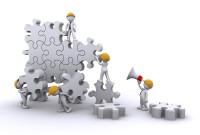- Home
- Business Processes
- Industry Knowledge
- Aerospace Industry
- Automotive Industry
- Banking Domain
- BFSI Industry
- Consumer/ FMCG Industry
- Chemicals Industry
- Engineering & Construction
- Energy Industry
- Education Domain
- Finance Domain
- Hospitality Domain
- Healthcare Industry
- Insurance Domain
- Retail Industry
- Travel and Tourism Domain
- Telecom Industry
- Leadership Skills
- eLearning
- Home
- Leadership
- Leadership & Management
- Types of Power in Leadership
Types of Power in Leadership
Power is the ability to exercise influence or control over others. Leadership involves authority and it is very important for leaders to understand what type of power they're using. The 5 Types of Power in Leadership are Coercive power, expert power, legitimate power, referent power, and reward power. Authority is the right to command and extract obedience from others. It comes from the organization and it allows the leader to use power.
In the functioning of a leader, the ability to guide the action of others is achieved through his or her authority. Carrying out of these decisions is accomplished because of the power of the leader. You will see the relationship between the authority and power of a leader as we go further to understand various types of power.
1. Legitimate Power:
This power comes to the leader when the organization’s authority is accepted. It comes from the rules of the organization. For e.g. parents, teachers, managers, police, etc. have legitimate power only when their authority is accepted in the positions they hold.
2. Expert Power:
This is the power of knowledge and skill of special kinds that is important in getting the job done. A person’s professional competence or knowledge gives him or her expert power. The credibility increases and he or she can lead other persons to trust the judgments and decisions taken by the leader. A leader may not be an expert in all fields, but one can certainly take the help of experts in particular fields as and when required.
3. Charismatic Power:
This is the power of attraction or devotion, the desire of one person to admire another. A subordinate feels a positive attraction towards a leader by identifying oneself, with the leader, or gets influenced by the leader’s attractive power. This power helps the subordinate to understand and value the leader so much that one understands and acts according to the expectations of the boss or the leader. It helps one to act as one’s own boss, and behave in ways one thinks the boss will want.
4. Reward Power:
This power is the present or potential ability to reward for worthy behavior. The superior or the leader has the power to give tangible rewards such as promotion, office space, time off from work, attractive work assignments, and help to the subordinate. Also, psychological rewards like praise, appreciation, approval, and recognition can be given by the leader or the superior to the subordinate. The subordinate has to believe that the leader has access to higher authorities; therefore, the leader can give rewards. This reward power of the leader can also increase the leader’s charismatic and legitimate power.
5. Coercive Power:
This is the ability to threaten or punish. The leader can give tangible punishment like dismissal, demotion, low rating, less satisfying work assignments, etc. Psychological punishments include criticism, avoidance, disapproval or satirical remarks, etc. on the subordinate. The reward power helps to avoid something undesirable. The self-esteem of the subordinate will increase because of reward power. It also decreases because of punishment or coercive power. Even a subordinate may withdraw or break the rules or become hostile. One may not feel attracted to the charismatic power of the leader and at times may ignore the leader’s legitimate power. Having seen the reasons for differences between the authority and power of the leader, you should know the type of leaders as understood on the basis of their authority and power.
Besides the power aspect one should also account for the following:
Formal Leader:
A formal leader is selected by the organization. For example, a manager is a formal leader by virtue of the authority coming from the organization. He or she influences others to help accomplish the goals of the organization or unit. Such leadership lasts over a long period of time.
Informal Leader:
An informal leader is chosen by the group. Thus, all managers are leaders if their authority is accepted, but not all leaders are managers. Informal leadership is leadership without position and may shift from one person to another. It may last for a brief time. Most people are leaders at one time or the other and they can have an influence on others as defined by the concept of leadership itself.
The ideal leader is the one who can combine formal and informal leadership simultaneously within himself or herself.
Related Links
You May Also Like
-
The best career choices are ones that match your values. Each person has several values that are important to him. These values are highly personal and knowing them provides a clearer sense of what's most important to you in your life and career. Career values are the beliefs you consider important from a work standpoint. Values help you understand what you want from a job? Explore a few examples of work values that can influence career path and job satisfaction.
-
Management theories are the recommended management strategies that enable us to better understand and approach management. Many management frameworks and guidelines were developed during the last four decades.
-
In today's business world, proficiency in management skills is essential for career growth and success. Managerial skills can be defined as attributes or abilities that are essential for every leader and manager to succeed and fulfill specific tasks expected from them by the organization.
-
Power is the ability to exercise influence or control over others. Leadership involves authority and it is very important for leaders to understand what type of power they're using. The 5 Types of Power in Leadership are Coercive power, expert power, legitimate power, referent power, and reward power. Authority is the right to command and extract obedience from others. It comes from the organization and it allows the leader to use power.
-
Hawthorne Studies - Leadership
The Hawthorne studies were conducted on workers at the Hawthorne plant of the Western Electric Company by Elton Mayo and Fritz Roethlisberger in the 1920s. This study established the behavioral change that happened due to an awareness of being observed, resulting in active compliance with the supposed wishes of researchers, because of special attention received, or positive response to the stimulus being introduced.
-
Team leadership theory is a recent leadership theory that does not discriminate between the leader and the other team members. The approach considers contributions from each team member to be critical for organizational success. This approach focused on the overall team effectiveness and team problems are diagnosed and action is taken to remediate weakness. This approach provides for taking corrective action when the leader deems necessary.
-
What are the functions which a leader does to establish as a leader? What are the activities undertaken by them to become great leaders, rather revolutionary leaders? The most important tasks done by a leader in all situations are defining the vision, mission, and goals, leading the team, administrative functions, motivating followers, decision making and conflict resolution, and continuous development.
-
Max Weber gave the theory of Bureaucratic Management in 1915. Bureaucracy is a specific form of organization defined by complexity, division of labor, professional management, and hierarchical management control. Weber's theory has two essential elements - organizational hierarchy and rules-based management. Weber made a distinction between authority and power and advocated that authority must be given to the most competent and qualified people.
-
McClelland's Theory of Needs is a human motivation theory which states that an individual's specific needs are acquired over time through our culture and life experiences. As per the three needs theory, these acquired needs significantly influence the behavior of an individual. The three main driving motivators are the needs for achievement, affiliation, and power.
-
Managers have to perform many roles in an organization, and how they handle various situations will depend on their style of management. Management styles are the characteristic ways, of making decisions relating to subordinates. These are the strategies, efforts, or direction used by the manager, to create an efficient workplace, to achieve organizational goals. A management style is the method of leadership used by a manager.
Explore Our Free Training Articles or
Sign Up to Start With Our eLearning Courses

About Us
Learning
© 2023 TechnoFunc, All Rights Reserved










